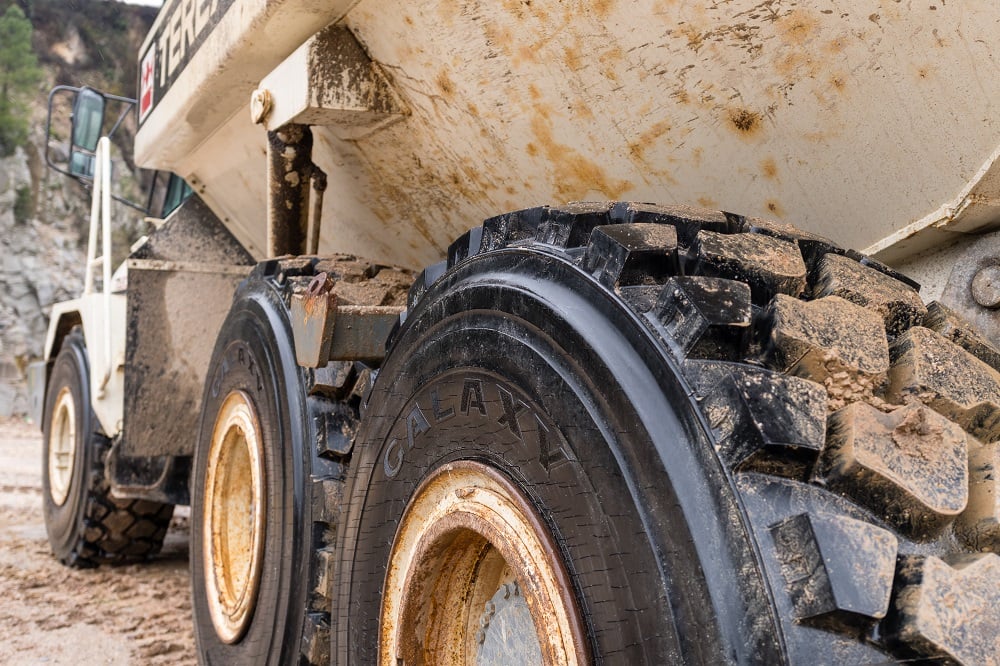Managing Construction Tires for Better ROI
After labor and fuel, tires are the third-highest operating cost on a wheeled piece of heavy equipment. Having a proactive approach to the management and maintenance of your construction equipment’s tires can equal big gains over the course of its lifetime. Making tires last longer is easy and just taking a few simple steps can save you a substantial amount on your tire spend.

Five Tips for Longer Lasting Tires
1. Equip with Application-Specific Tires
Yokohama Off-Highway Tires prides itself on building application-specific tires—that is tires built especially to meet the demands of the machines they’re mounted on, the jobs they’re asked to perform, and the conditions they work in. Matching your equipment’s tires to their application is one of the best methods for improving their service life, along with performance and return on investment (ROI).
A variety of factors play a role in determining how a tire will perform in a particular application, including:
- Construction (solid, radial, or bias ply)
- Tread pattern: (bars, blocks, or no tread at all)
- Tread depth
- Rubber compounds
For example, using radials, like our Alliance 585, will ensure lower heat buildup than bias-ply tires, which is a big benefit in applications where machines travel at high speeds and cover long distances. Another advantage of radials is that they can last up to three times as long as their bias counterparts. Conversely, a solid tire like the Galaxy LHD 510 SDS will outlast pneumatic options in puncture-prone applications such as demolition.
While no one tire can do it all, our Alliance 550 MultiUse comes close. Available for machines ranging from excavators and backhoes to telehandlers and skid steers, the 550 features robust steel-belted radial construction and a unique tread pattern that is just as at home on concrete and asphalt as it is in snow and sand.
2. Don’t Mix Different Types of Tires
Once you’ve chosen an application-specific tire, stick with it (or, if you’re going to make a change, make it all at once). Tires are designed to work together to transfer a machine’s power to the ground, provide traction, and influence handling. Consequently, mismatching tires on your equipment can speed up tire wear and, even worse, wreak havoc on your drivetrain. Mismatched tires can also increase fuel usage, reduce productivity, and compromise handling. Ultimately, mixing tires can cost a lot more in repairs and performance than the expense of new tires.
If you must mix tires, go with tires with the same construction, similar tread depths, comparable tread patterns, and make sure the tires have the same outer diameter.
3. Know Your Tire’s Limits
Understanding the limitations of your tires and not pushing past them is a key step toward longer-lasting tires. The Tire and Rim Association (TRA) has adopted a classification system that makes it easy to understand a construction tire’s intended application. Tires are also assigned a Load Index from the TRA, which indicates how much weight they are capable of carrying and at what weight and inflation pressure they can carry the load. Remember that load changes on equipment with reach—like telehandlers and buckets—so make sure to consult the machinery manufacturers' charts to determine the load on a tire when a heavy payload is extended away from the axle.
At best, exceeding the limits—weight capacity, speed, and length of travel—of construction tires can speed up tire wear. At worst, it can have catastrophic consequences and lead to everything from productivity-destroying downtime to creating serious safety issues.
4. Adjust Inflation Pressure
Operating your tires at their optimal inflation pressure—the inflation pressure recommended for the load of your machine and the speed at which it will travel—is an extremely important factor to the life of your tires. Both overinflation and underinflation can lead to numerous issues that will quicken the demise of tires:
- Underinflation can cause excessive wear—tire life decreases 10% for every 10% it is underinflated—as well as cracks and sidewall separation
- Overinflation can result in accelerated wear and impact breaks
The more frequently you check the inflation pressure of your tires (and adjust as needed), the better. Ideally, you should check the tire pressure of construction equipment daily. If daily checks aren’t feasible, aim to do one at least weekly. Inflation pressure should be taken when the tire is cool—and remember, it can take a large OTR a considerable amount of time to cool—so a best practice is to check inflation first thing in the morning before the machine has run.
Have trouble making sense out of all the numbers? Work with your local dealer to dial in the proper inflation pressure for the load and speed of your equipment.
5. Inspect Often
Paying attention to what your tires are telling you is one of the easiest ways to enhance their lifespan, which is why you should get in the habit of visually inspecting your construction equipment’s tires before operation. Tire wear can hint at issues like overinflation and underinflation, which if caught in time can save unnecessary wear and other issues. Examining tire wear can also help you identify the types of tires that will work best for you in the future. Likewise, damage such as cutting and chunking can signal that you’re using the wrong tire.
Yokohama Off-Highway Tires Construction Range
Yokohama Off-Highway Tires has an application-specific tire option to deliver lasting performance, dependable operation, and superior ROI. Whether solid or pneumatic, block tread or bar, extra-deep tread or smooth, our construction tires are designed to meet the real-world challenges facing our customers—and you can further the advantage our tires offer by following the tips above. Contact your local YOHTA dealer or rep today to learn more about our extensive range of construction tires.


